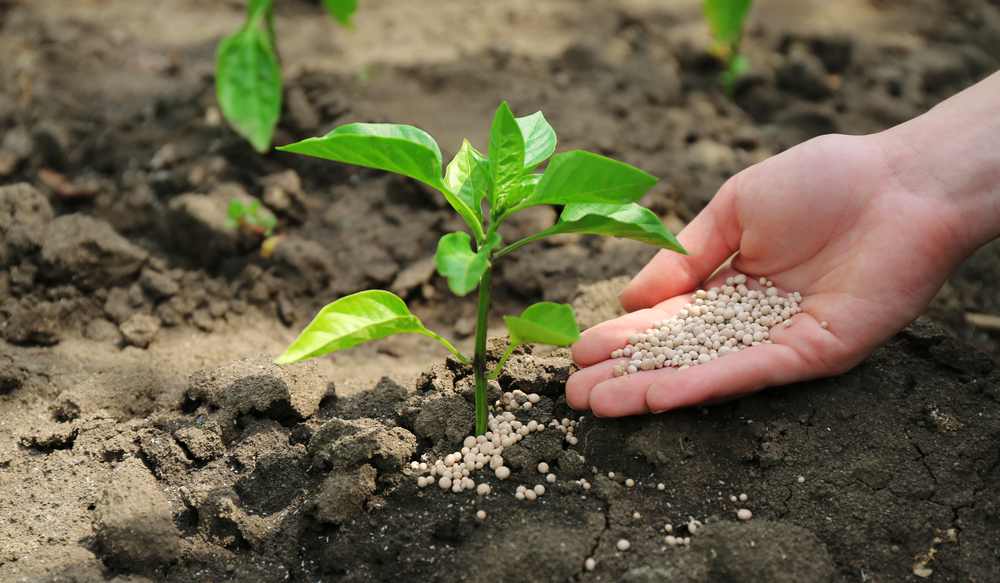Fertilizer & Xeriscape: Tips To Help Your Landscape Thrive
One of the bonuses of a water-saving (xeriscape) landscape is that it needs less fertilizer than its water-thirsty counterparts. However, soil health is essential to the healthy lifecycle of your garden’s flower plants, shrubs, and trees. When soil becomes depleted, plants begin to starve, so regular fertilizer applications prevent soil depletion altogether.
A depleted plant has a higher risk of succumbing to disease and is less able to combat common pests. By using suitable fertilizer, at the correct times, home and business owners ensure their living landscapes have what they need to thrive.

Xeriscape Fertilizing: Information & Tips
The more you learn about soil, plant needs, and the ins and outs of fertilizers, the better equipped you are to nourish your landscape as needed.
1. Fertilizing needs depend on soil quality
Plants, shrubs, and trees depend on about 16 mineral elements for their “nutrition.” They get most of the oxygen, nitrogen, carbon, and hydrogen they need from the air and water. However, plants depend on soil to deliver the rest. The most necessary of these elements are:
- Nitrogen
- Phosphorus (P)
- Potassium (K)
If you worked with a xeriscape landscape designer, you might remember they focused on soil analysis. Part of this analysis was to learn more about the mineral element balance in the existing soil. From these results, they used amendments to create a richer soil biome. Over time, plants consume essential minerals leaving soil depleted without additional fertilizer boosts.
If it’s been a while since your soil was tested, or you aren’t sure where to start, it’s worth having your soil tested in different landscape areas. First, mark them well, so you know where they came from, and then have them tested at a local nursery or through a landscape professional that offers soil testing. This is the best way to learn precisely what your soil needs, after which you can select customized fertilizer treatments and amendments.
2. Select eco-friendly fertilizers
Xeriscapes inherently support their environments. They’re designed to honor the water available on-site and from the average area rainfall, with minimal input through irrigation. And because we use native plant species, waterwise landscaping is also designed to attract pollinators and other wildlife, creating an eco-friendly habitat. Therefore, the fertilizers you select can make or break the entire plan.
Always select organic or eco-friendly fertilizers that use minimal to no chemicals or synthetic ingredients. This minimizes the risk of nutrient runoff into rivers, lakes, and streams or toxic poisoning of crucial insects, pollinators, and soil microbes.
3. Understanding the numbers
Remember we said the three essential mineral elements for plants and trees are nitrogen, phosphorous, and potassium? When you purchase fertilizer for your landscape, the container will have numbers representing each product’s ratio of Nitrogen: Phosphorous: Potassium. Some of these ratios are set for “general” fertilizer, while others are specific to flowering and fruiting plants, leafing plants, particular types of grass, etc.
You’ll also notice that some of the most commercially-known fertilizers have very high ratios (like 11:7:7 or 15:9:12). In contrast, organic or eco-friendly fertilizers have lower numbers (more like 6:3:2 or 3:2:3). That’s because most commercial fertilizers are artificially loaded with powerful chemicals to achieve immediate results. Organic/eco-friendly brands use animal and plant residues.
The less powerful, but better for the environment, alternatives are fine for a well-maintained xeriscape. With Xeriscape, less is more in every way. That includes less water and less need for fertilizers. The continuity of proper, organic fertilizer application yields consistent, long-term results with virtually zero harmful effects on beneficial organisms.
4. Fertilizer timing is important
In almost all cases, we recommend fertilizing plants, trees, and shrubs twice yearly: once in fall and once in spring. This achieves a balance where wintering roots have access to nutrients as they gear up for their re-emergence in spring. Then, once dormant winter plants come back to life, a spring dose of fertilizer gives them the extra nutrients they need to produce lush foliage and flowers through the summer.
Bring your plant list or xeriscape design map to a local nursery, and they’ll help you select specific fertilizers as necessary. However, you can also purchase a general, all-purpose organic fertilizer and apply it as directed if you prefer to keep things simple. If you contract with a local landscape maintenance company, speak to them about fertilizing. If they automatically fertilize as part of their services, you don’t want to apply extra as more is not better, and you can harm plants if they’re over-fertilized.
5. Don’t forget the power of mulch as fertilizer
In a Science Direct post about fertilizer, researchers state, “Organic fertilizers contain plant- or animal-based materials that are either a byproduct or end product of naturally occurring processes, such as animal manure and composted organic materials.” That is a good reminder that while commercial fertilizers are purchased from a nursery, fertilizer is always made when organic matter decomposes.
That includes organic mulch that decomposes and acts as fertilizer for your plants in addition to minimizing moisture loss and weed growth. Decomposing mulch materials like shredded hardwood bark, straw, coarse compost, or shredded native tree cuttings are fantastic year-round landscape enhancements. They both protect and nourish the landscape while also benefitting solid microbes. Applying and maintaining healthy layers of mulch further minimize fertilizer needs.
Connect With Xeriscape Maintenance Pros & Learn About Fertilizer
Not exactly sure what to use or how to fertilize your xeriscape? Contact us, and we’ll schedule a visit. We love educating clients on the best xeriscape maintenance practices and can help you select and apply fertilizers to help your landscape thrive.
Tagged: fertilizer, Landscape Maintenance, xeriscape, xeriscape landscaping
You can leave a response, or trackback from your own site. Back to Top
Leave a Reply





